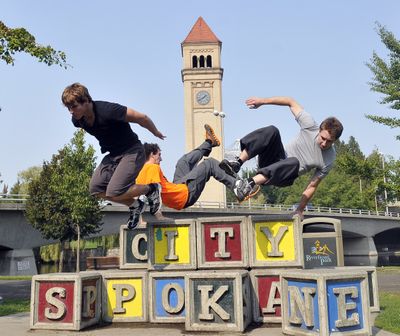Prayer Parkour runs, jumps, rolls with flow

Tucked into a corner of Riverfront Park, near the big red wagon, are a pair of large, concrete planters, one uphill from the other.
At least, that’s what most people would see. Jarrod Swanson sees opportunity. He scans the city landscape – garbage cans, railings, stairways, benches – and asks: “How can I play with it?”
He sprints at the planter, leaps onto the front edge of the first one with both feet and tries to spring upward and onto the second one – but he loses his balance and falls backward.
“Dude!” calls his friend Nicholas Murray. “You’re leaning back!”
“I know!” Swanson answers.
Swanson, Murray and a third member of the team, Joey Penchoen, are engaged in parkour – the free-form urban gymnastics that started in France and has become a staple of movie stunts. While high-flying, big-air parkour has gotten a lot of attention, our city doesn’t lend itself to Spider-Man theatrics. And yet Swanson, Murray and Penchoen are trying to make the most of it, finding opportunities to leap, vault, roll, spin and otherwise play on the built environment of the Lilac City.
Swanson and Murray, both 20, are Medical Lake High School graduates who run track at Spokane Falls Community College; Penchoen, 21, is also from Medical Lake, and he attends Eastern Washington University. They all have various athletic interests. Murray is a former break dancer who turned away from gymnastics for something with less structure.
If you saw them doing their thing – and if you had an idea of parkour from the movies or YouTube – you might be struck initially by the care and caution they bring to it. They warm up extensively. They plot and discuss their moves. They evaluate them after the fact. They coach and goad each other. When they get their moves polished, they shoot video of them, analyze them for improvement and post them on YouTube.
But what is it, exactly? What is all this running and jumping around?
“I don’t honestly think it’s a sport. It’s not a competition with others,” Swanson said. “We just call it exercise when people ask about it. Or an art form.”
In parkour, a “traceur” identifies the most efficient route through an architectural environment, running, rolling, jumping, climbing and vaulting. The through line from move to move is what they call flow, and flow is crucial. It’s where personal style emerges, where the possibility for expression and even artistry comes out, and it’s the source of the group’s name: Prayer Parkour. That is not a reference to religion, Murray said, but to the notion of operating under something higher.
“We think about the flow as something higher,” Murray said.
Of course, it often doesn’t look like such a high-minded affair to outsiders. A bunch of young men jumping around on public property – they often get treated like vandals or hoodlums. Twice, they’ve been kicked off the grounds of the Thomas S. Foley Federal Building, a parkour wonderland of architectural features.
“That place was great,” Murray said wistfully.
But the guys insist they’re not out to do damage or cause trouble.
“They don’t understand we’re not there to terrorize them, we’re just there to exercise and show our flow,” Swanson said.
At Riverfront Park earlier this week, the members of Prayer Parkour showed their flow. Murray and Swanson are the more experienced of the three, and they coached Penchoen. Murray did running leaps onto the large concrete blocks by the red wagon – springing off into a flip called a “front Webster” and landing with a roll on the grass. That roll – from one shoulder to the opposite hip – is a critical for traceurs, in that it allows them to absorb a lot of impact without getting hurt. Or very hurt, anyway.
Murray also executed a “double Kong” – using his hands to leap, ape-like, over a concrete obstacle – in between watching and advising Swanson: “Knees, Jarrod!”
At one point, he decides to try the double-planter jump himself. He almost makes it, before falling backward.
“Doesn’t count!” Swanson yells.
“It’s farther than you’ve gotten,” Murray answers.
They take a break. Murray and Penchoen size up a bent metal post that’s missing its sign. They eyeball possible ways to use it for a jump or move. Murray rests, catches his breath, then makes another assault on the planters.
He runs and leaps explosively onto the front rim of the first planter, and then bounds up, off a single leg, onto the second, where he lands on two feet. And sticks.
“There!” Murray shouts.
That accomplished, the members of Prayer Parkour go off in search of other objects to jump on or over, other things to climb, other places to play.
“Usually we do three hours,” Swanson says, “and then we go get Slurpees!”